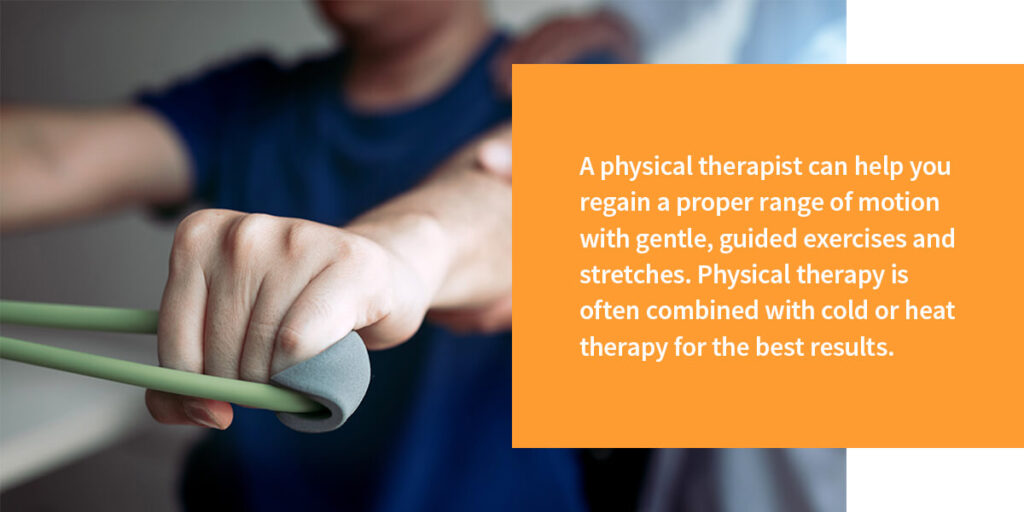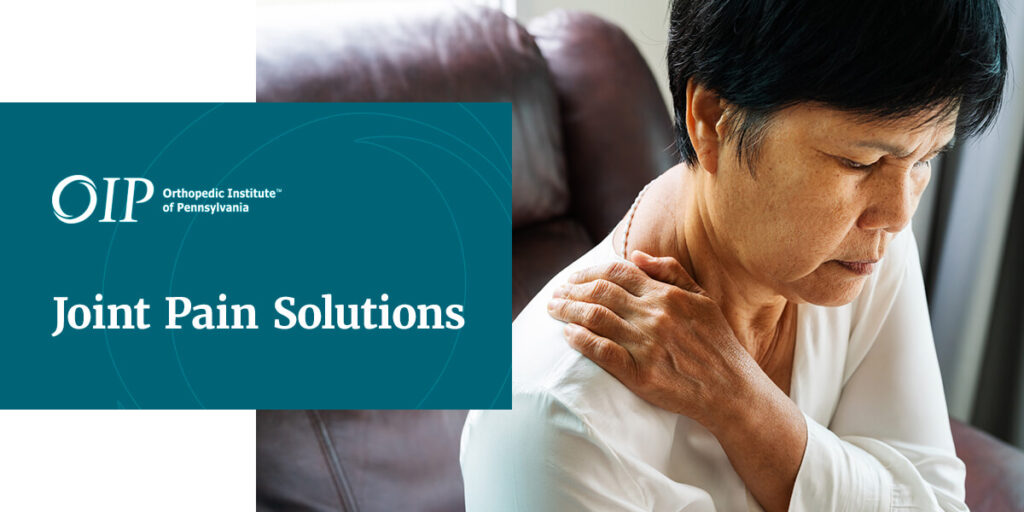Jump to:
Joint pain can occur in various body parts, including the shoulders, knees, and hips. Previous joint injury, weight, age, underlying medical conditions and joint overuse can increase the risk of developing joint pain. While joint pain may be constant, it can also occur episodically.
Along with pain, you may notice your joints feel sore, achy or stiff, with a limited range of motion. Severe joint pain may cause throbbing, burning or grating sensations. Fortunately, numerous joint pain solutions minimize joint pain and inflammation and restore a proper range of motion.
Natural Remedies
Many natural or at-home remedies provide relief for joint pain. Generally, natural remedies are often the first line of treatment people consider when they experience joint pain, while more severe pain may require professional intervention. Many at-home treatments are effective for mild to moderate pain. Some of these at-home joint pain solutions include:
Ice and Heat
Ice and heat therapy is an effective joint pain remedy that can alleviate joint pain, discomfort and inflammation. Applying an ice pack to a sore joint can improve swelling and painful symptoms. Generally, experts recommend icing a painful joint for 15 minutes two to three times a day or as needed to improve symptoms. Physicians recommend applying ice first before heat therapy when joint pain becomes noticeable.
After a day or two, you can apply a heating pad or hot water bottle to improve joint pain and alleviate any muscle spasms. If you don’t have a heating pad, you can take a hot shower, bath or even immerse a painful joint in a basin of hot water. When using heating pads, you should only apply the pad directly to the joint for 20 minutes at a time.
Rest
Rest is essential for joint and muscle pain relief and can take the strain and pressure off an injured or damaged joint. If you notice pain in a joint, you should rest the joint immediately and avoid any activities that may aggravate joint pain. Rest can reduce inflammation and swelling around the joint and alleviate pressure.
While exercise can help a painful joint, knowing when rest is necessary is important. If exercise or simple movements are causing pain, discomfort or limited mobility, you should rest the joint for at least one day. Rest, along with ice and heat therapy, can minimize joint pain. After symptoms improve, you may continue gentle exercises to strengthen the joint and surrounding muscles.
Exercise
Exercise is another important solution for joint and muscle pain relief. It is important only to exercise if you are not experiencing severe joint pain or related symptoms. Exercise can improve flexibility, increase strength and minimize joint pain and stiffness.
Swimming is an excellent exercise for those with joint pain because aquatic activities alleviate pressure and strain on sore joints. While exercise may seem intimidating for those with joint pain, exercising can maintain bone strength, enhance balance, keep an ideal weight and provide energy for the day.
Medical Remedies
Many patients may need medical remedies for moderate to severe joint pain. If you don’t experience relief from at-home treatments, you may want to see your physician and learn more about common medical remedies for joint pain. Some of the most common medical treatments to improve joint pain include:
Corticosteroid Injections
Corticosteroid injections can ease joint pain and minimize inflammation around the joint, preserving the joint’s function. Corticosteroid shots use anti-inflammatory medication to improve various medical conditions, including joint pain and stiffness.
When corticosteroid shots are injected into the joint, the medicine helps minimize inflammation, alleviating pressure on the joint and surrounding structures. Corticosteroid injections can provide joint pain relief from six weeks to six months, depending on your symptoms.

Physical Therapy
Physical therapy is another beneficial treatment for joint pain that can stabilize a joint while strengthening the surrounding muscles. A physical therapist can help you regain a proper range of motion with gentle, guided exercises and stretches. Physical therapy is often combined with cold or heat therapy for the best results.
While physical therapy is quite effective for improving joint pain, it is most effective when combined with proper diet and other joint pain treatments. During physical therapy, you will learn low-impact exercises that improve joint pain and prevent further discomfort.
Over-the-Counter Pain Medicine
Over-the-counter (OTC) pain medication can minimize discomfort and improve pain-related symptoms for general joint pain and discomfort. Certain OTC medicine can reduce inflammation, improving swelling and joint pressure. Common OTC pain medicine includes aspirin and ibuprofen.
If you take other medications, you should consult your physician before adding any OTC pain relievers. If you don’t need an OTC pain reliever for swelling, you can use acetaminophen to reduce pain. When taking acetaminophen, you should avoid drinking any alcohol.
Types of Joint Pain
The joints are the connection between bones, providing your body with support as your move. When a joint becomes damaged or injured, it can cause pain, discomfort, swelling and limited mobility. Research suggests approximately one out of every four adults in the United States are affected by joint stiffness or pain.
While acute joint pain typically only lasts a few weeks, chronic joint pain can last for months and frequently occur in episodes. Even acute joint pain can negatively impact your overall quality of life. Understanding where your joint pain is located and what may be causing the discomfort can help you find an effective treatment. Some of the most common types of joint pain include:
Knee Pain
The knee is a common joint in the body that can become sore or painful. Knee joint pain can develop from an injury or age as the joint begins to wear down. Knee joint pain often causes an inability to fully extend or straighten the knee and difficulty placing full weight on the knee.
You may notice knee instability, weakness, stiffness or inflammation with knee joint pain. Other common symptoms of knee joint pain include redness, popping noises and the skin being warm to the touch. Approximately 25% of adults experience chronic knee pain.
Shoulder Pain
Approximately 18% to 26% of adults experience shoulder pain at any point in time, meaning it is one of the most common regional pain conditions. The shoulder is a complex joint designed to rotate 360 degrees. While the shoulder joint is impressive in its mobility, it may be prone to pain or stiffness.
Initially, shoulder pain may start as a mild, dull ache and slowly worsen over the next few days or weeks with continual use. Moderate or severe shoulder pain may develop suddenly with more noticeable symptoms. Shoulder joint pain may cause grinding sensations, limited movement and tender redness or inflammation.
Hip Pain
The hip joints are the body’s largest ball-and-socket joints, allowing for fluid movement. The hip joints connect the thighbones to the pelvis, allowing you to walk, run, stand and sit. While the hip joint can withstand repeated use, these joints can become painful and sensitive if they experience too much wear and tear.
Contact Orthopedic Institute of Pennsylvania
At the Orthopedic Institute of Pennsylvania, our providers are experts in all aspects of orthopedic care and are dedicated to providing the highest level of patient care. We are proud to offer innovative treatments for back pain, foot pain, hand pain and neck pain.
Request an appointment online today to learn more about joint pain and joint pain treatments.




